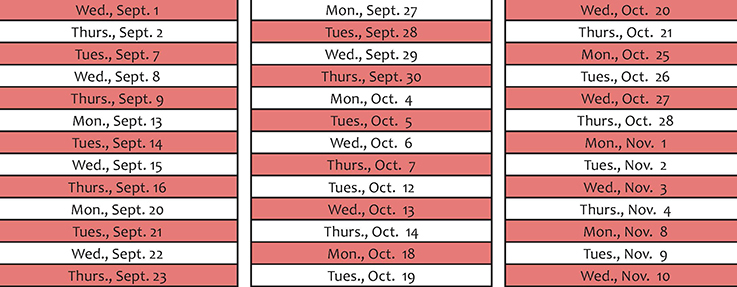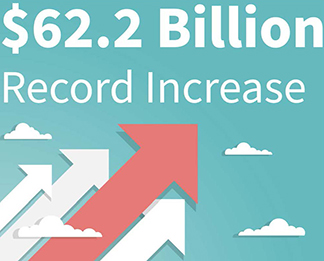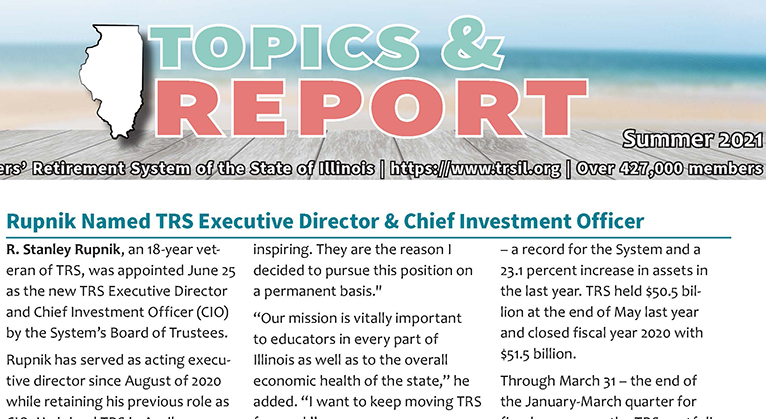Rupnik Named TRS Executive Director & Chief Investment Officer
R. Stanley Rupnik, an 18-year veteran of TRS, was appointed June 25 as the new TRS Executive Director and Chief Investment Officer (CIO) by the System’s Board of Trustees.
Rupnik has served as acting executive director since August of 2020 while retaining his previous role as CIO. He joined TRS in April 2003 as director of investments and was named CIO in November of 2004. He previously served TRS as acting executive director between 2009 and 2011. The Board voted unanimously to appoint Director Rupnik and conclude a nationwide search for a new leader at TRS, which is the 40th largest public pension system in the United States.
He replaces former Executive Director Richard W. Ingram, who resigned last August.
“We as a Board feel very comfortable with the way Stan has managed this wonderful institution,” said TRS Board President Devon Bruce. “You have done a great job in the last year and will continue to do so.”

“I believe strongly in the staff we have at TRS,” Director Rupnik said. “The last year has been extremely challenging for them in a number of ways. Their professionalism and dedication in the face of rapidly changing circumstances has been inspiring. They are the reason I decided to pursue this position on a permanent basis."
“Our mission is vitally important to educators in every part of Illinois as well as to the overall economic health of the state,” he added. “I want to keep moving TRS forward.”
Service to the System’s 427,000 members remains the highest priority. An average of $586 million in benefits is distributed in full and on time every month. Each week, staff handles approximately 2,300 phone calls and 680 emails from members and schedules 160 one-on-one counseling appointments.
In recent months, assets in the TRS Investment Portfolio have reached record levels, taking advantage of a surging national economy that broke free of last year’s COVID-19 downturn. As of May 31, TRS managed assets totaling $62.2 billion – a record for the System and a 23.1 percent increase in assets in the last year. TRS held $50.5 billion at the end of May last year and closed fiscal year 2020 with $51.5 billion.
Through March 31 – the end of the January-March quarter for fiscal year 2021 – the TRS portfolio recorded a positive 16.4 percent investment return, net of fees. For the 12-month period that ended in March, TRS performance was a positive 24.3 percent, net of fees.
In the last five years, the total assets in the TRS portfolio managed by Minority and Women Business Enterprises (MWBE) has increased from $8.2 billion to $14.5 billion. In each of the last five years, TRS has exceeded its annual aspirational goal to have 20 percent of total assets managed by MWBE firms. Currently, TRS commitments to MWBE firms total $14.5 billion, or 24.3 percent of the System’s total $59.5 billion portfolio.
Director Rupnik holds a bachelor’s degree in economics and a master’s degree in business administration from the University of Illinois at Urbana-Champaign. A native of Springfield, he lives in the Capitol City with his wife Kristen and their two daughters.
Legislature Addresses Impact of COVID-19 on Teacher Retirements
During the spring legislative session, the General Assembly approved three bills designed to help correct the unforeseen effects of the COVID-19 lockdown on TRS members who will be retiring in the next few years.
Senate Bill 2017 was signed into law on June 17, 2021 and is now Public Act 102-0016. The rest of these measures await action by Gov. JB Pritzker.
Public Act 102-0016 - calculating the Final Average Salary

Many teachers and administrators did not earn stipends and other extra pay that they would have in a year without the coronavirus because of remote learning and the cancellation of sports and extracurricular activities during the 2020-21 school year.
As a result, most member creditable earnings reported to TRS for the 2020-21 school year are expected to be lower than in previous years and future years.
Under the prior state law, if teachers who taught during 2020-21 were planning to retire within the next four years, they were required to use their four highest, consecutive salaries in their “Final Average Salaries” (FAS), which is a key element of the formula for a member’s initial pension. In most cases, a member’s last four salaries constitute their “four highest consecutive salaries.”
That calculation would have included the reduced salary for 2020-21 for the next four years because of the “consecutive” requirement. Then, the FAS for retiring members would have been lower than it would have been if COVID had never happened. Therefore, their initial pension would be lower than it would have been if COVID had never happened.
To correct this, the law removed the requirement that the FAS calculation use the four “consecutive” highest salaries. Effectively, the salary for the 2020-21 COVID-19 school year does not have to be used in an FAS calculation.
TRS will calculate the highest average for each member. For Tier 1 members, that means the FAS calculation will use the four highest salaries in the member’s last 10 years of service. For Tier 2 members, the law will require the highest eight salaries in the last 10 years of service.
This change only applies to members who are retiring after June 1, 2021 and would have to use the 2020-21 school year in their FAS calculations. If the 2020-21 salary is not used in the FAS calculation, then the “consecutive” requirement stays in place.
Public Act 102-0016 – exemptions to the 6% extra contribution threshold
This law creates new exemptions for overload, stipend work and increased instructional time from the state requirement that school districts pay a higher contribution to TRS if they grant a raise to a TRS member on the verge of retirement that is greater than 6 percent from one year to the next.
The exemption for “overload” pay that boosts a TRS member’s total salary by more than 6 percent may be applicable if the 2020-21 and/or 2021-22 school years are used in the calculation of a retiree’s final average salary. The bill also allows the exemption in a year when a school district is “unable to offer or allow… overload work due to an emergency declaration limiting such services.”
Similarly, the exemption for “stipend” pay that boosts a TRS member’s total salary by more than 6 percent may be applicable if the 2020-21 and/or 2021-22 school years are used in the calculation of a retiree’s FAS, or in a year when a school district is “unable to offer or allow… stipend work due to an emergency declaration limiting such services.”
The exemption for “increased instructional time” pay that boosts a TRS member’s total salary by more than 6 percent may be applicable only if the 2020-21 school year is used in the FAS calculation.
It is probable that adding overload, stipend and/increased instructional time to a teacher’s base salary in the 2020-21 and/or 2021-22 school year will boost that member’s total compensation by more than 6 percent over her/ his prior year’s pay. Under normal circumstances that would trigger the 6 percent threshold and require added TRS contributions from the school district.
Under a 2005 state law, annual raises of more than 6 percent for a teacher that effectively is within four years of retirement requires the school district to pay the long-term cost of that member’s retirement benefit created by the portion of the raise that is greater than 6 percent.
The exemptions are designed to save school districts money. Due to COVID-19 restrictions in 2019-20 and 2020-21, limited or no overload or stipend work occurred and teachers did not have that supplemental pay added to their base salaries. Increased instructional time may be needed by school districts in the 2020-21 school year.
Another bill, Senate Bill 1646, would create an exemption for summer school instruction that would apply to the 2020-21, 2021-22 and/or the 2022-23 school years.
In addition, the General Assembly approved other legislation of interest to TRS members.
House Bill 1966 & Senate Bill 1646 – allowing members to claim private school service credit
Both of these bills allow TRS members a temporary opportunity to “establish optional credit for up to 2 years of service as a teacher or administrator employed by a private school recognized by the Illinois State Board of Education…”
In either bill, the teacher must have been certified or licensed by ISBE while working for the private school, must have at least 10 years of TRS service credit and must pay the applicable member contribution for the private school time.
Under HB 1966, teachers can apply to TRS for this private school service time between the date the bill is signed into law and June 30, 2022. Senate Bill 1646 opens a two-year window with a deadline of June 30, 2023. Members interested in purchasing private school credit should contact TRS no earlier than September 2021 to request the Private School certification.
House Bill 2569 – new retired teacher deadline for “subject shortage” areas
This legislation extends the life of the “subject shortage area” law from June 30, 2021 to June 30, 2024.
With the approval of their regional school superintendent, school officials can declare that they have a shortage of qualified teachers in a particular subject and can hire retired teachers to fill those vacancies. Retired teachers filling those vacancies do not lose their pension benefits.
Senate Bill 1989 – moving the “sunset” date for increased post-retirement work limits
This legislation extends the “sunset” date of the enhanced post-retirement limits to June 30, 2023.
Under state law, a retired TRS member will not lose her/his pension benefit if he/she teaches for up to 100 days or 500 hours during a single school year.
Because of the chronic teacher shortage in Illinois, the limits on post-retirement teaching were extended between 2011 and 2021 to 120 days or 600 hours.
Senate Bill 2103 – future “auto enrollment” in TRS Supplemental Savings Plan
This legislation amends the 2017 state law that requires TRS to develop an optional defined contribution retirement plan to supplement the existing defined benefit pension plan.
The new TRS offering will be called the Supplemental Savings Plan (SSP).
The bill states that “as soon as practicable” on or after January 1, 2022, TRS “shall automatically enroll” all new members of the System into the SSP. All existing active members will have the option of joining the SSP and will not be automatically enrolled.
While new members are automatically enrolled, they can “opt out” of the SSP within 90 days from her/his first day of employment. A member who opts out of the SSP will receive a full refund of the contributions he/she has paid into the SSP.
For all auto enrollments, TRS will begin to collect 3 percent of each new member’s salary for her/his SSP account on her/his 30th day of employment. A member can elect to have more or less than 3 percent of her/his salary placed in the SSP.
On or after Jan. 1, 2023, TRS can increase all SSP participants’ automatic annual contributions beyond 3 percent. However, any contribution increase cannot be greater than 2 percent of any member’s pre-tax gross compensation per year.
The bill also requires all employers with TRS members “to comply with the reporting and administrative functions” established by TRS that “are required to implement the benefits established under” the SSP.
Board Vice President Retires; New Trustee Named by Gov. Pritzker

After eight years on the TRS Board, Trustee Mark A. Bailey of Palos Park is retiring. Most recently, Trustee Bailey has served as the vice president of the Board and in the past has chaired numerous Board committees, including the Claims Hearing and Rules and Personnel committees.
First elected in 2013 as a representative of “active” TRS members, Trustee Bailey is no longer eligible for that position because he retired from teaching in 2019. He also served as Director of Bands at Scott and River Woods schools in Naperville District 203, a position he held since 1994.
Trustee Bailey began his involvement with education policy at the state and national levels in the 1990s as a Building Representative within the Naperville Unit Education Association, progressing to become president of the NUEA in 2010. He also has served as a delegate to both the Illinois Education Association and National Education Association annual conventions.
Trustee Bailey will be replaced on the Board this summer by Trustee-elect Joseph Blomquist of Elgin.
In March, Gov. JB Pritzker appointed Mia Jazo-Harris to the Board.
Trustee Jazo-Harris, of Bloomington, has been a public affairs specialist with State Farm Insurance for more than 15 years. Previously, she served in public affairs for the State of Illinois at both the Capital Development Board and the Illinois Department of Agriculture. Trustee Jazo-Harris holds a Bachelor of Arts degree from Truman State University in Kirksville, Missouri.
Along with Trustee-elect Blomquist, incumbent trustees Fred Peronto of Elmhurst and Larry Pfeiffer of Carlinville will begin new four-year terms on the Board this summer. Both were unopposed for re-election to new terms this spring.
Under state law, the governor appoints seven members to the TRS Board and names the president.
Other trustees include the state superintendent of education, five trustees elected by contributing TRS members and two trustees elected by TRS annuitants.
Virtual Fall Member Meetings Explain Retirement & Benefits
TRS will host virtual meetings at 4:30 p.m. for members from September to November that are designed to explain the retirement process and to provide members with information about disability, death and insurance benefits.
The presentations have information for both Tier 1 and Tier 2 members.
An email alert will be sent in mid- to late August to register for a meeting. If you would like to be informed of this schedule via email and we do not already have your email address, you can add it to your official TRS record. You may enter your email address in the secure Member Account Access area online or call us at 877-927-5877.

Wait Four Months to Receive a Refund of Retirement Contributions
Now that the 2020-21 school year is over, some teachers may not be returning to the classroom. These TRS members may apply as early as the day after their last day of teaching for a refund of their TRS contributions if they terminate teaching with a TRS employer. However, by law, a refund cannot be processed until four months have passed since the member’s final day of teaching.
A refund of retirement contributions, which consists of the portions used to pay the retirement annuity (7.5 percent) and the annual increases in the annuity (0.5 percent), should be carefully considered because it terminates the member’s benefits and will be costly to repay if the member returns to teaching in the future.
Contributions of 0.4 percent for the expired Early Retirement Option will also be refunded if a member has not already applied and received that refund. If the member receives a refund of retirement contributions, she/he is not entitled to any other refunds. The contribution for the Teachers’ Retirement Insurance Program and the 1 percent survivor benefit contribution are not refundable.
After the member contacts TRS about the refund, TRS will send the application by regular mail.
The application can be returned any time after the member has formally resigned from her/his TRS-covered position. Once a properly completed refund application and any required supplementary earnings information from the school district(s) are received, we will process the refund and forward it to the Office of the Comptroller for payment when four months have passed following the member’s final day of teaching.
TRS Investments Soar Despite COVID-19 Economic Downturn in 2020

In recent months, assets in the TRS investment portfolio earnings have reached record levels, taking advantage of a surging national economy that broke free of last year’s COVID-19 downturn. That’s good news for all TRS members.
As of May 31, TRS managed assets totaling $62.2 billion – a record for the System and a 23.1 percent increase in assets in the last year. TRS held $50.5 billion at the end of May last year and closed fiscal year 2020 with $52.3 billion.
Through March 31 – the end of the January-March quarter for fiscal year 2021 – the TRS portfolio recorded a positive 16.4 percent investment return, net of fees. For the 12-month period that ended in March, TRS performance was a positive 24.3 percent, net of fees.
These results are much improved from the January-March quarter of fiscal year 2020, when the coronavirus affected the world economy and cut into the System’s assets.
All public pension systems lost money during the January-March quarter of fiscal year 2020. But compared to similar public pension systems, TRS ranked among the nation’s leaders in its ability to preserve assets. During the January-March quarter, the TRS investment return was negative 9.95 percent, net of fees. However, an analysis of the 300 largest U.S. institutional investors indicated that the median return for public pension plans then was negative 12.6 percent.
Through forethought and careful planning, the TRS Investment Department successfully navigated the perils of the pandemic’s attack on the economy. It took several months, but TRS was able to rebuild the value of the System’s portfolio to prepandemic levels – and beyond in subsequent months.
The low point during the early months of the pandemic saw TRS assets at $48.5 billion at the end of March. By the end of Sept. 2020, TRS had worked back to $53.5 billion in investment assets, a 10.3 percent rebound in value. Prior to the pandemic, TRS began Jan. 2020 with $54.2 billion in assets.
Annual Enrollment Period for TRAIL Medicare Advantage
TRAIL Medicare Advantage Prescription Drug (MAPD) Initial Enrollment for Medicare Eligible Members
Beginning January 1, 2021, the State of Illinois began requiring all retirees, annuitants and survivors to enroll into a healthcare program called Total Retiree Advantage Illinois (TRAIL) effective the date the member becomes eligible to enroll in Medicare, either due to age or disability. This program provides Medicare-eligible members and their covered dependents comprehensive medical and prescription drug coverage through TRAIL Medicare Advantage Prescription Drug (commonly referred to as “MAPD”) plans. TRAIL MAPD plans are Medicare-approved plans that combine the different parts of Medicare into one plan.
Since these plans are a type of Medicare, members must continue to pay federal Medicare premiums even after enrolling into a TRAIL MAPD Plan.
For members who are newly-eligible for Medicare, you have two opportunities for the TRAIL MAPD enrollment:
- Initial Enrollment (IE): Members can enroll within 60-days of the 65th birthday (of the youngest enrollee). Initial enrollment is a one-time offering.
- Annual Enrollment (AE): Members can enroll within a 30-day window mid-October through mid-November each fall.
The TRAIL Medicare Advantage Prescription Drug (MAPD) Open Enrollment Period for the 2022 plan year will be held this fall from mid-October through mid-November.
Most TRIP members who are eligible for Medicare Parts A and B are required to enroll in one of the TRAIL MAPD plans offered in her/his county of residence in order to keep TRIP insurance coverage.
In the fall, CMS will send out information about the TRAIL Program.
If you are already enrolled in TRAIL, you have two options:
- If you want to make a change to your TRAIL insurance coverage or add a dependent, the fall Open Enrollment Period is the time when you can make that change.
- If you want to maintain your current TRAIL coverage, you don’t have to do anything. Your insurance coverage will automatically continue as it is in 2022.
Visit the Total Retiree Advantage Illinois (TRAIL) Program page on the Central Management Services website at MyBenefits.illinois.gov for more information.
Summer 2021. Published by the Teachers' Retirement System of the State of Illinois.

